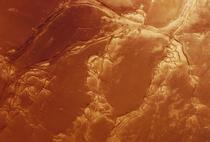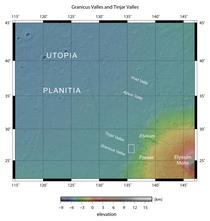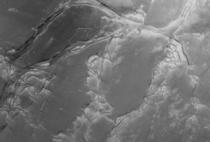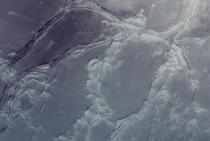Navigation/Menü: Links auf weitere Seiten dieser Website und Banner
28.07.2006
HRSC Press Release #272 - Granicus Valles Tinjar Valles (orbit 1383)
 RGB Farbbild #1 |
On 14 February 2005 the High-Resolution Stereo Camera (HRSC) onboard the ESA spacecraft Mars Express obtained image data in orbit 1383 with a ground resolution of approximately 23.7 meters per pixel. The data were acquired in the regions of Granicus Valles and Tinjar Valles, at approximately 26.8° northern latitude and 135.7° eastern longitude.
 Kontextkarte |
The northwest aligned Granicus Valles and Tinjar Valles are part of the Utopia-Planitia region, an area thought to be covered by a layer of lava that flowed from the northwest flanks of Elysium Mons into the Utopia-Planitia Basin. Today this once smooth volcanic plain is parted by channels of variable size and appearance, such as Granicus Valles (towards west) and Tinjar Valles (towards north).
 Nadiraufnahme #1 |
Both channel systems evolve from a single main channel entering the image scene from southeast, exhibiting an approximate width of 3 km and extending 300 m below the surrounding terrain at maximum. The impressive sinuous lava channel emanates from the mouth of a radial to the Elysium rise trending tectonic graben (see MOLA context map).
Dieser lang gestreckte, 4 km breite und 120 km lange Graben wird als Quelle von sowohl Lavaströmen als auch Geröllströmen (bestehend aus einem Wasser / Schutt Gemisch), die die Granicus und die Tinjar Valles geformt haben, interpretiert. Gleichartige tektonische Gräben in höheren Regionen entlang der Flanke von Elysium weisen keine Anzeichen vergleichbarer Aktivität auf. Diese Höhenabhängigkeit lässt vermuten, dass auch unterirdisches Wasser, mobilisiert durch vulkanische Aktivität, eine Rolle bei der Formung der heute sichtbaren Talsysteme gespielt hat.
This narrow, straight, 4 km wide and 120 km long graben is interpreted as the source of both lava flows and debris flows that carved Granicus and Tinjar Valles. Similar Elysium flank tectonic grabens at higher elevation lack outflow channels. This elevation dependence leads scientists to suggest that subsurface water, released by volcanic activity, has later played a role in shaping the channels visible today.
Die Farbansichten wurden aus dem senkrecht blickenden Nadirkanal und den Farbkanälen erstellt, die Schrägansicht wurde aus den Stereokanälen der HRSC berechnet. Die Anaglyphen werden aus dem Nadirkanal und einem Stereokanal abgeleitet. Die schwarzweißen Detailaufnahmen wurden dem Nadirkanal entnommen, der von allen Kanälen die höchste Auflösung zur Verfügung stellt.
The colour scenes have been derived from the three HRSC-colour channels and the nadir channel. The
perspective views have been calculated from the digital terrain model derived from the
stereo channels. The anaglyph image was calculated from the nadir and one stereo channel.
The black and white high resolution images were derived form the nadir channel which provides the
highest detail of all channels.
 Rot-Cyan Anaglyphe #1 |
The High Resolution Stereo Camera (HRSC) experiment on the ESA Mars Express Mission is led by the Principal Investigator (PI) Prof. Dr. Gerhard Neukum who also designed the camera technically. The science team of the experiment consists of 40 Co-Investigators from 33 institutions and 10 nations. The camera was developed at the German Aerospace Center (DLR) under the leadership of the PI G. Neukum and built in cooperation with industrial partners (EADS Astrium, Lewicki Microelectronic GmbH and Jena-Optronik GmbH). The experiment on Mars Express is operated by the DLR Institute of Planetary Research, through ESA/ESOC. The systematic processing of the HRSC image data is carried out at DLR. The scenes shown here were created by the PI-group at the Institute for Geological Sciences of the Freie Universitaet Berlin in cooperation with the German Aerospace Center (DLR), Institute of Planetary Research, Berlin.
Download
hochaufgelöste Bilddaten / high resolution image data
| Kontextkarte: |
| Nadiraufnahme #1: |
| RGB Farbbild #1: |
| Rot-Cyan Anaglyphe #1: |
© Copyright: ESA/DLR/FU Berlin (G. Neukum)

 English
English

